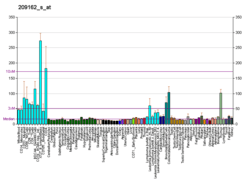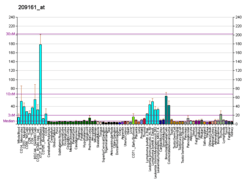PRPF4
U4/U6 small nuclear ribonucleoprotein Prp4 is a protein that in humans is encoded by the PRPF4 gene.[5][6][7]
The removal of introns from nuclear pre-mRNAs occurs on complexes called spliceosomes, which are made up of 4 small nuclear ribonucleoprotein (snRNP) particles and an undefined number of transiently associated splicing factors. PRPF4 is 1 of several proteins that associate with U4 and U6 snRNPs.[supplied by OMIM][7]
References
- 1 2 3 GRCh38: Ensembl release 89: ENSG00000136875 - Ensembl, May 2017
- 1 2 3 GRCm38: Ensembl release 89: ENSMUSG00000066148 - Ensembl, May 2017
- ↑ "Human PubMed Reference:".
- ↑ "Mouse PubMed Reference:".
- ↑ Lauber J, Plessel G, Prehn S, Will CL, Fabrizio P, Groning K, Lane WS, Luhrmann R (Sep 1997). "The human U4/U6 snRNP contains 60 and 90kD proteins that are structurally homologous to the yeast splicing factors Prp4p and Prp3p". RNA. 3 (8): 926–41. PMC 1369537. PMID 9257651.
- ↑ Horowitz DS, Kobayashi R, Krainer AR (Dec 1997). "A new cyclophilin and the human homologues of yeast Prp3 and Prp4 form a complex associated with U4/U6 snRNPs". RNA. 3 (12): 1374–87. PMC 1369579. PMID 9404889.
- 1 2 "Entrez Gene: PRPF4 PRP4 pre-mRNA processing factor 4 homolog (yeast)".
Further reading
- Maruyama K, Sugano S (1994). "Oligo-capping: a simple method to replace the cap structure of eukaryotic mRNAs with oligoribonucleotides". Gene. 138 (1–2): 171–4. doi:10.1016/0378-1119(94)90802-8. PMID 8125298.
- Horowitz DS, Krainer AR (1997). "A human protein required for the second step of pre-mRNA splicing is functionally related to a yeast splicing factor". Genes Dev. 11 (1): 139–51. doi:10.1101/gad.11.1.139. PMID 9000057.
- Wang A, Forman-Kay J, Luo Y, et al. (1997). "Identification and characterization of human genes encoding Hprp3p and Hprp4p, interacting components of the spliceosome". Hum. Mol. Genet. 6 (12): 2117–26. doi:10.1093/hmg/6.12.2117. PMID 9328476.
- Suzuki Y, Yoshitomo-Nakagawa K, Maruyama K, et al. (1997). "Construction and characterization of a full length-enriched and a 5'-end-enriched cDNA library". Gene. 200 (1–2): 149–56. doi:10.1016/S0378-1119(97)00411-3. PMID 9373149.
- Heng HH, Wang A, Hu J (1998). "Mapping of the human HPRP3 and HPRP4 genes encoding U4/U6-associated splicing factors to chromosomes 1q21.1 and 9q31-q33". Genomics. 48 (2): 273–5. doi:10.1006/geno.1997.5181. PMID 9521884.
- Kojima T, Zama T, Wada K, et al. (2001). "Cloning of human PRP4 reveals interaction with Clk1". J. Biol. Chem. 276 (34): 32247–56. doi:10.1074/jbc.M103790200. PMID 11418604.
- Gonzalez-Santos JM, Wang A, Jones J, et al. (2002). "Central region of the human splicing factor Hprp3p interacts with Hprp4p". J. Biol. Chem. 277 (26): 23764–72. doi:10.1074/jbc.M111461200. PMID 11971898.
- Strausberg RL, Feingold EA, Grouse LH, et al. (2003). "Generation and initial analysis of more than 15,000 full-length human and mouse cDNA sequences". Proc. Natl. Acad. Sci. U.S.A. 99 (26): 16899–903. doi:10.1073/pnas.242603899. PMC 139241. PMID 12477932.
- Reidt U, Wahl MC, Fasshauer D, et al. (2003). "Crystal structure of a complex between human spliceosomal cyclophilin H and a U4/U6 snRNP-60K peptide". J. Mol. Biol. 331 (1): 45–56. doi:10.1016/S0022-2836(03)00684-3. PMID 12875835.
- Ingelfinger D, Göthel SF, Marahiel MA, et al. (2004). "Two protein-protein interaction sites on the spliceosome-associated human cyclophilin CypH". Nucleic Acids Res. 31 (16): 4791–6. doi:10.1093/nar/gkg660. PMC 169899. PMID 12907720.
- Stanĕk D, Neugebauer KM (2004). "Detection of snRNP assembly intermediates in Cajal bodies by fluorescence resonance energy transfer". J. Cell Biol. 166 (7): 1015–25. doi:10.1083/jcb.200405160. PMC 2172029. PMID 15452143.
- Gerhard DS, Wagner L, Feingold EA, et al. (2004). "The status, quality, and expansion of the NIH full-length cDNA project: the Mammalian Gene Collection (MGC)". Genome Res. 14 (10B): 2121–7. doi:10.1101/gr.2596504. PMC 528928. PMID 15489334.
- Andersen JS, Lam YW, Leung AK, et al. (2005). "Nucleolar proteome dynamics". Nature. 433 (7021): 77–83. doi:10.1038/nature03207. PMID 15635413.
- Barrios-Rodiles M, Brown KR, Ozdamar B, et al. (2005). "High-throughput mapping of a dynamic signaling network in mammalian cells". Science. 307 (5715): 1621–5. doi:10.1126/science.1105776. PMID 15761153.
- Rual JF, Venkatesan K, Hao T, et al. (2005). "Towards a proteome-scale map of the human protein-protein interaction network". Nature. 437 (7062): 1173–8. doi:10.1038/nature04209. PMID 16189514.
- Liu S, Rauhut R, Vornlocher HP, Lührmann R (2006). "The network of protein-protein interactions within the human U4/U6.U5 tri-snRNP". RNA. 12 (7): 1418–30. doi:10.1261/rna.55406. PMC 1484429. PMID 16723661.
- Huang B, Ahn YT, McPherson L, et al. (2007). "Interaction of PRP4 with Kruppel-like factor 13 regulates CCL5 transcription". J. Immunol. 178 (11): 7081–7. doi:10.4049/jimmunol.178.11.7081. PMC 2674583. PMID 17513757.
This article is issued from
Wikipedia.
The text is licensed under Creative Commons - Attribution - Sharealike.
Additional terms may apply for the media files.





